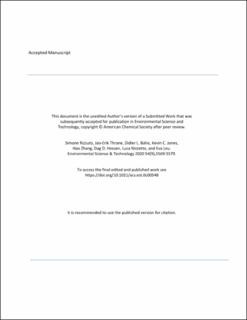| dc.contributor.author | Rizzuto, Simone | |
| dc.contributor.author | Thrane, Jan-Erik | |
| dc.contributor.author | Baho, Didier Ludovic | |
| dc.contributor.author | Jones, Kevin C. | |
| dc.contributor.author | Zhang, Hao | |
| dc.contributor.author | Hessen, Dag Olav | |
| dc.contributor.author | Nizzetto, Luca | |
| dc.contributor.author | Leu, Eva Susanne | |
| dc.date.accessioned | 2020-09-24T07:00:37Z | |
| dc.date.available | 2020-09-24T07:00:37Z | |
| dc.date.created | 2020-09-06T12:30:49Z | |
| dc.date.issued | 2020 | |
| dc.identifier.citation | Environmental Science and Technology. 2020, 54 (9), 5569-5579. | en_US |
| dc.identifier.issn | 0013-936X | |
| dc.identifier.uri | https://hdl.handle.net/11250/2679377 | |
| dc.description | Embargo until 15 April 2021 | en_US |
| dc.description.abstract | The acquisition of tolerance to an environmental stressor can result in organisms displaying slower growth after stress release. While well-grounded in the theory, empirical evidence of the trade-off between stress tolerance and organism fitness is scarce and blurred by the interaction with different environmental factors. Here, we report the effects of water browning on the responses, tolerance acquisition, and associated trade-offs in a population of microalgae exposed to sublethal concentrations of organic micropollutants over multiple generations. Our results show that dissolved organic matter (DOM) reduces toxic responses and modulates tolerance acquisition by the algae, possibly by complexing micropollutants. Microalgae that acquire tolerance allocate resources to fitness at the cost of reduced cell size. They yield higher productivity than nonadapted ones when grown in the presence of micropollutants but lower in their absence. The net trade-off was positive, indicating that adaptation can result in a higher productivity and fitness in tolerant species in recurrently stressed environments. | en_US |
| dc.language.iso | eng | en_US |
| dc.publisher | American Chemical Society | en_US |
| dc.title | Water browning controls adaptation and associated trade-offs in phytoplankton stressed by chemical pollution | en_US |
| dc.type | Peer reviewed | en_US |
| dc.type | Journal article | en_US |
| dc.description.version | publishedVersion | en_US |
| dc.source.pagenumber | 5569-5579 | en_US |
| dc.source.volume | 54 | en_US |
| dc.source.journal | Environmental Science and Technology | en_US |
| dc.source.issue | 9 | en_US |
| dc.identifier.doi | 10.1021/acs.est.0c00548 | |
| dc.identifier.cristin | 1827560 | |
| cristin.ispublished | true | |
| cristin.fulltext | original | |
| cristin.qualitycode | 2 | |
